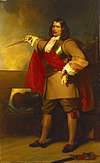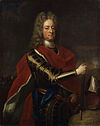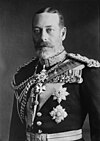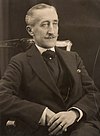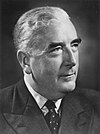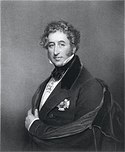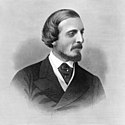Lord strážce pěti přístavů
Lord strážce pěti přístavů (Lord Warden of the Cinque Ports) je čestná ceremoniální funkce ve Spojeném království. Jako jedna z nejstarších a dodnes existujících institucí v Anglii byl zřízen v 11. století (název lord strážce pěti přístavů „Cinque Ports“ se ustálil až ve 13. století). Ve středověku byl lord strážce pěti přístavů faktickým správcem jižního pobřeží Anglie s rozsáhlými pravomocemi v politickém uspořádání království. Přibližně od doby anglické revoluce ztratil úřad politický vliv, ale jako čestná hodnost byl udělován významným osobnostem britských dějin včetně sedmi premiérů. Díky bezmála tisícileté existenci je hodnost lorda strážce pěti přístavů dodnes prestižním postem v hierarchii dvorských úřadů Spojeného království. V letech 2004–2022 funkci zastával bývalý vrchní velitel britského loďstva velkoadmirál baron Michael Boyce (1943–2022).
Historie

Když Vilém I. Dobyvatel v roce 1066 ovládl Anglii, z vlastní zkušenosti poměrně snadné možnosti dobytí britských ostrovů si byl vědom zranitelnosti jižního anglického pobřeží. Proto vybral pět přístavů, jimž udělil zvláštní výsady a postavení nezávislé na správě hrabství, kam administrativně spadaly. Jednalo se o města Sandwich, Dover, Hythe, Romney a Hastings, později k nim přibyly ještě přístavy Winchilsea a Rye. Do čela tohoto zvláštního samosprávného celku byl postaven guvernér se sídlem na hradě Dover Castle. Původní název funkce byl Keeper of the Coast, pojmenování lord strážce pěti přístavů se ustálilo až ve 13. století. Kromě výsad měly jmenované přístavy také povinnosti, a to především stavbu a vyzbrojování lodí pro státní potřeby, stejně jako udržování určitého počtu válečných plavidel ve svých loděnicích. Lord strážce také nominoval poslance za přístavy do Dolní sněmovny. Jednalo se o 16 poslaneckých mandátů, takže přibližně do 16. až 17. století měl lord strážce i značný politický vliv. Poklesem významu jmenovaných přístavů došlo k redukci poslanců parlamentními reformami v letech 1832 a 1885 na pouhé tři[1]. Následnou zákonnou úpravou místní samosprávy zanikl i institut tzv. pěti přístavů.
Přibližně od doby restaurace Stuartovců nebyly s úřadem lorda strážce pěti přístavů spojeny žádné mimořádné pravomoce, funkce však přetrvává dodnes a díky téměř tisícileté tradici patří k nejvyšším čestným postům Spojeného království. Zhruba od 18. století byl úřad udělován jako čestná a často doživotní funkce pro významné osobnosti britských dějin, takže mezi lordy strážci pěti přístavů je několik premiérů (William Pitt mladší, Winston Churchill) nebo slavných vojevůdců (maršál Wellington). Úřad zastávalo během historie také několik členů královské rodiny, mezi nimi i jedna žena, královna-matka Alžběta. Po její smrti zůstala funkce dva roky neobsazena a od roku 2004 je lordem strážcem pěti přístavů bývalý vrchní velitel loďstva Spojeného království velkoadmirál baron Michael Boyce (*1942).
Walmer Castle

Původním sídlem lorda strážce pěti přístavů byl hrad Dover Castle v Kentu, v 18. století se oficiální rezidencí stal hrad Walmer Castle, postavený v letech 1539–1540 Jindřichem VIII. jako součást obranného systému proti případné francouzské invazi. Z nepohodlného Doveru se do Walmer Castle jako první nastěhoval vévoda z Dorsetu, který byl lordem strážcem pěti přístavů téměř čtyřicet let a zahájil stavební úpravy stírající původní ráz vojenské pevnosti. Úpravám hradu a parku se věnovali i jeho další nástupci (William Pitt nebo 2. hrabě Granville). Někteří lordi strážci zde také zemřeli, například vévoda Wellington. Hned při své první návštěvě zde zemřel také ministr financí William Henry Smith ještě předtím, než byl do funkce lorda strážce oficiálně uveden. Ve 20. století byl hrad Walmer Castle k dlouhodobým pobytům využíván již jen zřídka. V současnosti zůstává stále oficiálním sídlem lorda strážce pěti přístavů, ale spravuje jej organizace English Heritage a je přístupný veřejnosti.
Seznam lordů strážců pěti přístavů od 16. století
Odkazy
Poznámky
- ↑ Funkci obdržel ve věku dvou let a po dobu jeho nezletilosti jej zastupoval Edward Poynings, který pak po Jindřichově nástupu na trůn úřad formálně převzal.
- ↑ V roce 1660 byli naživu dva členové rodu Finchů se shodným křestním jménem Heneage a oba po restauraci Stuartovců zastávali vysoké funkce. I když z dostupných pramenů není úplně patrné, který z nich zastával v roce 1660 funkci lorda strážce pěti přístavů, většina zdrojů se dnes shoduje v tom, že se jednalo o 3. hrabě z Winchilsey, který měl s královskou rodinou blízké kontakty již z doby exilu.
- ↑ Zemřel ještě před oficiálním uvedením do funkce.
- ↑ Do funkce byl oficiálně uveden až po skončení druhé světové války v roce 1946.
Reference
Externí odkazy
Média použitá na této stránce
Autor: Rs-nourse, Licence: CC BY-SA 3.0
Coat of arms of Sir Thomas Cheney (or Cheyne) KG (c. 1485 – 16 December 1558) of the Blackfriars, City of London and Shurland, Isle of Sheppey, Kent,[1] was an English administrator and diplomat, Lord Warden of the Cinque Ports in South-East England from 1536 until his death.
See stall plate of Sir Thomas Cheney, KG in St. George's Chapel.
(c) Photo: Mark Rawlings/MOD, OGL v1.0
Portrait of the First Sea Lord Admiral Sir George Zambellas KCB DSC ADC.
The First Sea Lord is the professional head of the Royal Navy and a member of the Defence Council. He is responsible to Secretary of State for the fighting effectiveness, efficiency and morale of the Naval Service.
As a member of the Defence Council, the First Sea Lord supports the Secretary of State in the management and direction of the Armed Forces through prerogative and statutory powers. As a member of the Chiefs of Staff Committee, he advises CDS on maritime strategy and policy. He has a collective responsibility for providing strategic direction to the department, managing performance and ensuring that defence delivers the required outputs.
- Object Name: NWD_1651
- Organization: ROYAL NAVY
- Supplemental Categories: People, Royal Navy
- Keywords: First Sea Lord, Admiral, Sir, George Zambellas, Royal, Navy, Ministry of Defence, Northwood, Royal Navy, Personnel, Identifiable, Sailor, Male, Flag Officer, Adm
- Country: UK
Portrait of Sir John Boys
The Duke of Wellington, commander in chief of the Anglo-Portuguese and Spanish armies, which he led to victory in the Peninsula. He later commanded the Anglo-Allied army during the Waterloo campaign in 1815.
Freeman Freeman-Thomas, governor general of Canada
Portrait of Rufus Isaacs, 1st Marquess of Reading
Winston Churchill, Prime Minister of the United Kingdom from 1940 to 1945 and from 1951 to 1955.
Portrait of Henry VIII of England (1491-1547), reigned 1509-1547.
Autor: Rs-nourse, Licence: CC BY-SA 3.0
Coat of arms of Sir Richard Guildford, KG
- BURKE, Sir Bernard, The General Armory of England, Scotland, Ireland, and Wales: Comprising a Registry of Armorial Bearings from the Earliest to the Present Time, London: Harrison & sons, 1884.
| “ | Guildeford (Sir Richard Guildford, K.G. 1500, d. 28 Sept. 1506, and sir Henry Guildeford, K.G. 1526, d. 1532). Or, a saltire betw. four martlets sa. | ” |
A portrait drawing of an unidentified man. A bust length portrait facing three-quarters to the right. He wears a fur collar and hat with a feather and gold ornaments pinned to its brim.
Robert Blake, General at Sea, 1598-1657
This retrospective, highly romanticized portrait was painted some 170 years after Blake's death. It shows him full-length to the left, wearing a breast-plate and leather coat with a red sash and cloak, breeches, and stockings. He wears red ribbons on his shoes. He stands on the deck of a ship and, holding a sword in his gloved right hand, he points it over the gunwale and out to sea. He holds his other glove in his left hand and stands in front of a cannon, while to the right in the foreground the sheath of his sword lies on the deck.
Blake was one of the first to take up arms against King Charles I and as commander of the navy of Oliver Cromwell's Commonwealth became one of the most renowned seamen in English history. In 1640 he was elected to the Short Parliament and his staunch Puritanism led him to join the Parliamentary cause against King Charles I at the outbreak of the Civil War in 1642. He soon won fame as a general by brilliantly defending Lyme, Dorset, in 1644 and by holding Taunton, Somerset, from its besiegers for more than a year 1644-45. He was appointed General-at-Sea in 1649 and led the English fleet against the Dutch, 1652-54, and against the Spanish 1656-57. His articles of war and fighting instructions represented fundamental reforms, which helped to lay the foundations of England's maritime supremacy. The artist has played on 19th-century interest in the heroic to create this portrait, which was commissioned by Sir Robert Preston Bt., one of the Directors of Greenwich Hospital, for presentation to the Naval Gallery there in 1829. It was reputed to be based on a contemporary miniature of Blake.
Autor: Karen Roe from Bury St Edmunds, Suffolk, UK, United Kingdom, Licence: CC BY 2.0
Built during the reign of King Henry VIII, Walmer Castle is one of the most fascinating visitor attractions in the South East. Originally designed as part of a chain of coastal artillery defences it evolved into the official residence of the Lord Warden of the Cinque Ports. The Duke of Wellington held the post for 23 years and enjoyed his time spent at the castle and in recent years Her Majesty Queen Elizabeth the Queen Mother made regular visits to the castle.
The armchair in which Wellington died and an original pair of 'Wellington boots' along with some of the rooms used by the Queen Mother are among the highlights. And with the magnificent gardens, a woodland walk and some excellent bird spotting there's something for everyone to enjoy. There is also a pleasant cycle path along the beach front to nearby Deal Castle.Autor: Rs-nourse, Licence: CC BY-SA 3.0
Coat of arms of Sir Edward Poynings, KG. Poynings quartering Paston.
British prime minister, 1770–82.
Arms of Arthur Plantagenet D.1542), Viscount Lisle, KG, from a manuscript in the collection of the Society of Antiquaries, London. The shield shows quarterly of four: 1st: Quarterly France modern and England (royal arms); 2nd & 3rd: de Burgh; 4th: Mortimer; Over-all an inescutcheon of pretence of Grey, Viscounts Lisle, quarterly of six, 1st: Barry of six argent and azure in chief three torteaux (Grey, Viscount Lisle); 2nd: Barry of argent and azure, an orle of martlets gules (Valence, Earl of Pembroke); 3rd: Gules, seven mascles or conjoined 3, 3, 1 (Ferrers of Groby as heir to de Quincy);
4th: Gules, a lion rampant within a bordure engrailled or (Talbot); 5th: Gules, a fesse between six crosses crosslet or (Beauchamp); 6th: A lion passant crowned (Lisle); in chief a label of three points argent. The whole encircled by the Garter. The canting crest: On a chapeau gules turned up ermine with a capital letter A at the front, a genet cat party per pale sable and argent and a sprig of genista (broom plant)(c) GrahamPadruig, CC BY 3.0
Flag of the Lord Warden of the Cinque Ports, a traditional UK senior appointment. Note that this image shows the particular flag of Admiral Lord Boyce - the badge in the flag's hoist changes with the appointment of a new Lord Warden. Admiral Lord Boyce was preceded in post by Her Majesty Queen Elizabeth the Queen Mother, who used the same flag but with her Royal Cypher as the badge in the hoist.
The main part of the flag includes the famous front halves of lions joined to rear halves of ships, associated with the heraldry of the Cinque Ports and originally created by heraldic dimidiation.Autor:
Portrait inscribed as Theophilus Howard, 2nd Earl of Suffolk (1584-1640), possibly it is a portrait of his father, Thomas Howard, 1st Earl of Suffolk (1561-1626).
Robert Carr, Earl of Somerset, by John Hoskins (died 1670), given to the National Portrait Gallery, London in 1898. See source website for additional information.
This set of images was gathered by User:Dcoetzee from the National Portrait Gallery, London website using a special tool. All images in this batch have been confirmed as author died before 1939 according to the official death date listed by the NPG.Henry Brooke, 11th Baron Cobham (1564-1618/9) in Garter robes, wearing the chain of the Order of the Garter bearing the pendant of the Greater Saint George
William Henry Smith (1825-1891), Newsagent and politician
Autor: Pat19999, Licence: CC BY-SA 4.0
Henry FitzRoy, 1st Duke of Richmond and Somerset



















